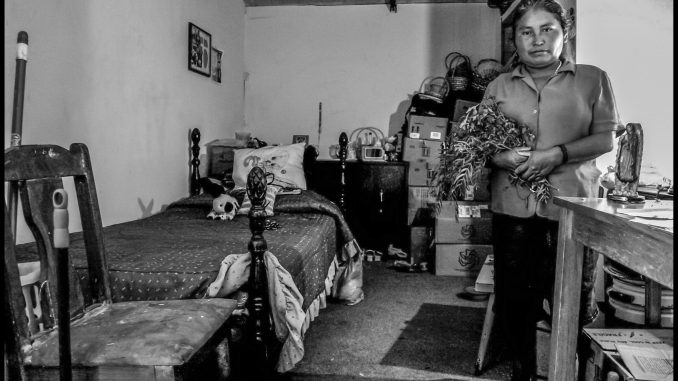
By David Bacon
This story is produced by the award-winning journalism nonprofit Capital & Main, as part of its Ill Harvest series, and co-published here with permission.
Gloria Merino came to the Salinas Valley from the Mixteca region of Oaxaca, where she’d learned how to help women deliver babies. “My cousin was a curandero [a practitioner of traditional medicine] and he taught me how to heal,” Merino recalls. “The Virgin, God and San Marcos all told me that I would heal people and make a living that way, so I learned to help deliver babies.”
In Greenfield, in the Salinas Valley, she became a partera, or midwife, to women who wanted to deliver at home, using methods their communities had depended on for generations. She had to start growing her own herbs, since she couldn’t find them in stores. “Triquis [the Oaxacan indigenous group to which she belongs] began to seek my help in healing or for trouble in their marriage,” she recalls.
Merino was careful not to attempt dangerous deliveries. “If a woman has a fetus in a breech position or she feels bad during pregnancy,” she says, “I rub almond oil on the mother’s stomach and give her herbs, but I don’t deliver breech babies myself. I just turn them around if they’re in that position.” For difficult births, she says, women go to the local Clínica de Salud del Valle de Salinas.
Although Merino saw midwifery as a calling, it was not easy to earn enough money from what indigenous immigrant women could pay her, so she also collected cans for recycling. But her biggest problem was that she had to practice in fear. “I heard that if you deliver at home, they can incarcerate the mother and father because it’s illegal,” she says.
Until 2014, California law made it illegal for midwives to work without the supervision of a doctor, and few, if any, doctors were willing to provide it. Today, changes in the law require that midwives be licensed and limit the types of deliveries they can perform.
Clinic connects with Mixtecos
Indigenous Mexican migrants like Merino now make up a large part of the farm labor force in California. In 2010, the Indigenous Farmworker Study estimated that, including children, about 165,000 people had come from towns in southern Mexico to work in the state’s fields.
They have their own system of health care and traditional medical practices, and once they’re in the U.S., that system comes up against the existing U.S. health care system. How the relationship between the two develops requires respect for their practices, as well as ensuring that indigenous families get the health care they need, regardless of the system.
These indigenous immigrants speak languages that were thousands of years old when the European colonization started. In California’s agricultural counties the two most common languages are Mixtec and Triqui, but people speak over a dozen others. There’s no more recent count, but the number of indigenous farmworkers has undoubtedly grown.
In agricultural regions like Oxnard and Greenfield, most Triquis and Mixtecos get their health care in community clinics when they choose to access western, or nontraditional, medicine. It’s often there that the divide between two cultures of health care becomes apparent.
Sarait Martinez, executive director of the Centro Binacional para el Desarrollo Indígena Oaxaqueño, says traditional practices, especially for giving birth, are a fundamental part of the rural indigenous culture of Mixteco and Triqui immigrants. “I don’t think traditional practices should be left behind,” she urges. “They’re part of who we are as an indigenous community, and it’s our responsibility to support the people who value them. Why can’t they be combined with our current medical system here in California?”
The question highlights the importance of the relationship between indigenous communities and health care institutions, especially community clinics. That relationship — and the ability of clinics to gain the confidence of migrants — plays a key role in determining what care is available to these farmworkers from southern Mexico.
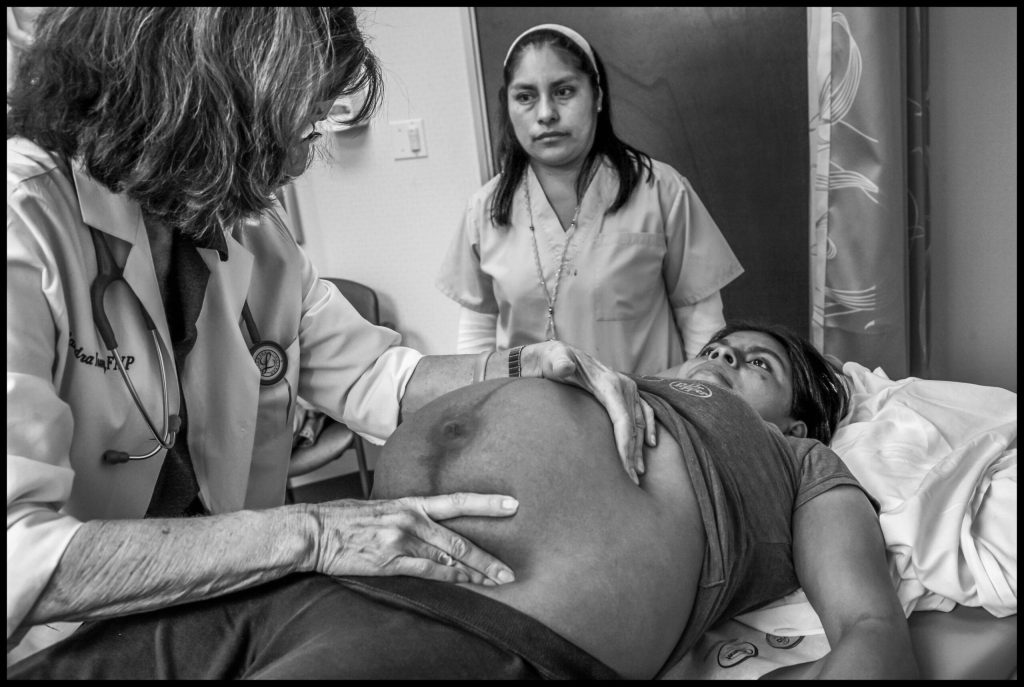
According to researcher Ed Kissam, “Many clinics like Clínica de Las Islas [the Las Islas Family Medical Group] in Oxnard were first organized by groups of progressive doctors, nurses and health care activists, who saw a community need and acted in the absence of support by the established health care system, in the era that followed the civil rights movement.”
Although indigenous migrants from Oaxaca began coming to work in California during the Bracero Program that ended in 1964, it was only in the 1980s that flows of indigenous migrants began to increase rapidly. So, in their early years, few of the clinics knew much about indigenous migrants. At Las Islas that began to change 23 years ago, when Sandy Young, a family nurse practitioner, realized that most of her farmworker patients were speaking Mixteco.
“The clinic started in the early ’80s, and it wasn’t until 1998 when the Mixteco community made its presence known,” she remembers. “I realized we couldn’t think that all we needed to do was hand people pieces of paper. I was the critic who said, ‘What was done yesterday can’t just be what we do today.’”
In the first step Young convinced clinic director Miguel Cervantes to hire Mixtec interpreters from the community, so that clinic staff could communicate with monolingual patients. But the clinic needed more than translation. Often women would come in with a paper bag full of papers they’d received in the mail or on previous visits. “Since they didn’t read English, and sometimes couldn’t read at all, everything went into that paper bag,” Young recalls. “So we needed case managers who could handle that, and do it in the language people understood. We had to get used to everyone coming into the exam room, kids and all, since no one had childcare.”
To help Mixtecos get used to the clinic, Young organized classes for 20 people in a conference room. “We explained how to prepare for a visit to the clinic, to create confidence so they’d come. On Saturday night the clinic became a community center, a safe and accepting place.”
Eventually the classes grew and she moved the meetings to the cafeteria, and then to a school. As Young realized that other needs in the community had to be addressed, she helped Mixteco activists establish a nonprofit organization, the Mixteco/Indígena Community Organizing Project (MICOP). “The community just called her Doctor Sandy, and went to her when they needed medicine, or a woman needed an appointment for a prenatal exam,” says Arcenio López, MICOP’s executive director.
Clínica and ICE
“Mexico and Oxnard have very similar circumstances, in terms of access to health care,” López explains. “Our indigenous community comes from the rural areas of Oaxaca, Puebla and the south, where people have lived as farmers for generations. Formal health care is a privilege for elites, so they depend on traditional medicine. Prenatal care doesn’t really exist, and a pregnant woman has her baby at home. It’s the health care system of the colonizer.
“People come to the U.S. and work for years and still can’t access health care. But at least there’s some possibility of it here. What determines whether they can get it are the priorities of the family. The first priority is to pay the rent, then to buy food and clothes. Health is not a priority because their economy doesn’t permit it.”
The Mixteco migration from Oaxaca to California began in the mid-1980s, so most Mixtecos were not eligible for the immigration amnesty of 1986, which had an eligibility cutoff date of January 1, 1982. Many, therefore, are undocumented. This also created special problems at the clinic.
“When the rumor mill warned that ICE [Immigration and Customs Enforcement agents] had roadblocks in Oxnard,” Young remembers, “no patients would show up. The fear is so huge. We tried to keep people’s immigration status out of patient records, and when we had the community meetings here I’d stand at the door, ready to defend people. Actually, I think one of the beauties of community clinics is that we’re kind of untouchable.”
MICOP’s López says that while clinics have to create safe spaces, understanding the importance of immigration status has to be deeper. “That fear becomes part of you — fear of big institutions and the government,” he explains. “It’s what happens when you cross the border, and you begin to think, ‘We’re breaking the law.’ You take the risk because your need is so great, but you try to keep quiet and not cause trouble. That fear has a big impact. You become so anxious, and your children pick up on it.”
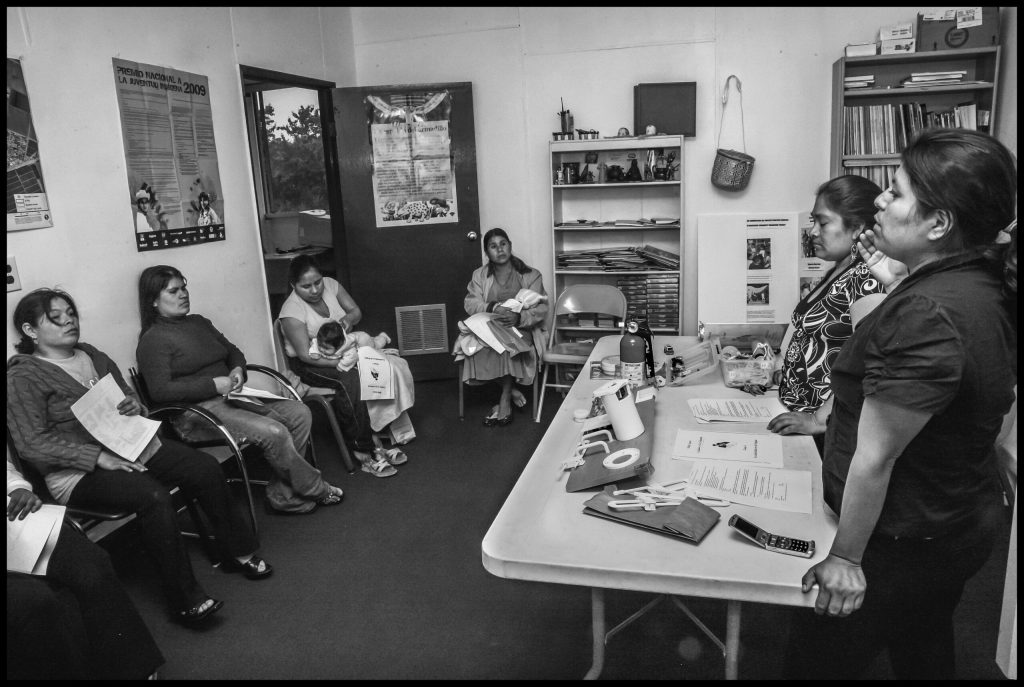
For over a decade the clinic tried to get people to come despite that fear. “But all our work was thrown into the trash when Trump came out with his public charge rule,” López says bitterly. “People heard that if they used any public services they’d never have a chance to get legal.”
Migration creates another challenge for providing consistent medical care. Most Mixteco farmworkers in Oxnard work as strawberry pickers during part of the year, and have to migrate north to find more work. Staff at the Las Islas Family Medical Group tried to develop a relationship with the Clínica Salud de la Gente in Watsonville — where pregnant women could go with a copy of their medical records — so they could keep track of any problems.
Pandemic hits
When the pandemic hit, the relationships between the Las Islas Family Medical Group and the Mixteco community proved their value. “In the first year of the pandemic,” Young says, “people were so frightened that they were unwilling to come to medical appointments. So we did what we could by phone, often while people were working in the fields, with an interpreter. Most farmworkers don’t have laptops or internet access. After talking with moms about children or pregnancy, we’d talk about what to do and what not to do, the symptoms and how to get tested. We’d schedule times for vaccinations so that no one had to wait in the waiting room.”
CBDIO’s relationships with community clinics were sometimes not as positive. “In Monterey County we had a hard time with the Clínica de Salud del Valle,” Sarait Martinez recalls. “When the pandemic hit, growers would take busloads of people in, including H-2A workers, and they’d get service right away. But when we’d ask about community people not getting service, they’d never get back to us. It was hard to get appointments for testing and you had to register online. Our staff did thousands of registrations in little towns, signing people up in places that were closest to them.” The clinic did not reply to an email asking for comment.
It took some months, in both Ventura and Monterey counties, but broad community-based networks were eventually created to fight the COVID-19 pandemic. In both counties, the networks relied on promotoras (community health workers) to fill crucial roles in fighting the pandemic — helping families get tested for COVID, distributing masks, explaining how to best avoid infection, organizing vaccination events. In Monterey County, CBDIO played a key role in the community coalition, reaching indigenous families and farmworkers, for example, going to the fields to distribute masks and water and talk with workers about safety. In Ventura County, MICOP promotoras trained by Sandy Young play a similar role, while MICOP’s popular community radio station Radio Indigena and its on-air host, Jesús Noyola, and others promoted vaccination.
“The state and counties partnered with us because we could speak indigenous languages and we had roots in our communities,” says Martinez. “Indigenous migrants are very diverse, but generally invisible within the larger Mexican immigrant population. We had 27 people speaking 15 Mexican indigenous languages. We don’t call them promotoras, because they don’t promote things. We call them community workers because that’s what they do.”
Ed Kissam emphasizes that relying heavily on promotoras began long before the pandemic, however. “Rural health clinics have relied on community health workers’ cultural capital and communication skills to provide counseling on diabetes, prenatal health, dental care and mental health. But often community health workers wonder how their roles can be expanded to do more than provide prepackaged health information or routine follow-up. What opportunities exist for promotoras to build greater skills? Can they provide unique insights on the social determinants of health in a local community or become more effective advocates?” he asks.
“As the COVID-19 pandemic continues, farmworker health will require adapting the national ‘Test to Treat’ model to assure easy access to testing as a basis for rapidly prescribing antivirals or monoclonal antibodies,” Kissam adds. “Orienting families to routine use of home testing to identify those at high risk for serious COVID illness could mean faster service and greater efficiency. These needs argue for expanding the roles of community health workers in farmworker clinics.”
Overcoming the divide
Kissam believes that rural community clinics can play a broader role addressing socioeconomic and environmental factors in California farmworker and immigrant communities. The initial efforts, he says, to create a distinctive rural health system, responsive to community input and relying on local community workers, came as a result of the War on Poverty in the late ’60s. In its earliest years, the White House Office of Economic Opportunity tried to integrate housing, employment, health, education and child development services into broad-based efforts to improve all aspects of community life.
“When the federal Rural Health Clinic Services Act passed in 1977, however, the definition of rural was so limited that it treated many farmworkers in California as urban rather than rural residents and affected funding,” Kissam says. “A still more serious problem today is coordinating bureaucratically defined funding into a coherent and flexible system responsive to diverse communities.”
Equally important, however, is the relationship between those clinics and the communities they serve. Within these communities are the traditional practitioners, like Gloria Merino. The lack of a role for them in the current medical system highlights the gulf that sometimes separates indigenous communities from community clinics. Fear of the criminalization of these practices makes this gulf wider.
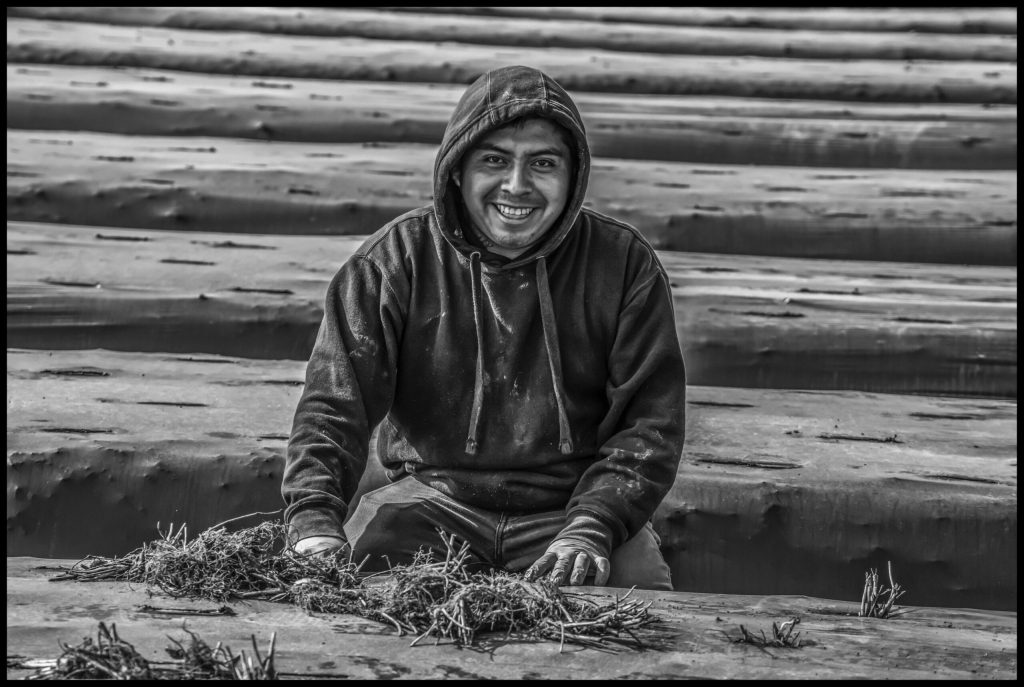
Arcenio López describes a case in which a mother gave manzanilla tea to a sick child, and a nurse reported the family to child services. “It just takes one case for that fear to make people stop using traditional practices. The irony is that it’s now becoming a luxury for white people to have midwives and babies at home. A recent training for midwives didn’t even include parteras.”
MICOP would like to see more recognition of the value of traditional medicine. “Clínica de las Islas and other community clinics should understand that we have two worlds here,” says López. “They could create more confidence in parteras by hiring them to help pregnant women, and train them in western practices. But if we don’t have a formal relationship with the clinics, we can’t achieve this or decide how we’ll work together.”
López says MICOP doesn’t currently have such a relationship with the Las Islas clinic, now operated by Ventura County, or the other local network of Clínicas del Camino Real. “Our relationship is based on the interpreters, who are key people,” he explains, “but a more formal relationship would involve continuous training for their staff about Mixteco culture and history, ways to overcome barriers to services, and mentoring community people. We need more than a meeting where they tell us about the clinic’s programs.”
In the wake of the pandemic, neighboring Santa Barbara County began reaching out to MICOP, asking for dialogue about what farmworker communities themselves think they need. “Santa Barbara’s [now former] Health Department Director Van Do-Reynoso talked directly with our community about the ways structural racism prevents access to health care. We proposed changes inside the structure of the system,” López says. “MICOP suggested creating health policy associates and health navigators, who would work on data collection, help people learn of services in their various languages and organize mobile clinic events, especially for new migrants.”
“Health can be impacted from the prevention aspect,” Do-Reynoso told the Santa Barbara Independent, “through changing policies, the environment, and systems to achieve a healthy community. And I’m proud of partnerships we formed; we linked arms with health care providers and community-based organizations and community leaders.”
CBDIO, however, has had more problems overcoming the divide between clinics and indigenous communities. “Clinics should be culturally and linguistically accessible,” says CBDIO’s Sarait Martinez. “Our people often don’t know how to read and write. They feel discriminated against when they’re told they have to fill out a form, and when they have trouble, someone says, ‘I can’t help you.’ They struggle to have access because they live far away, and often come only when their pain is unbearable. We have a base in farmworker communities and people trust us, so the state needs to support and pay attention to us. We were expected to respond to the emergency, because we knew that if we didn’t, our community would suffer, but in the past we never got much.”
Sandy Young retired two years ago, and in the end felt frustrated by the slow pace of change. “For me it was never just about treating individual patients. It’s about changing how our society is organized. So it is frustrating to realize that my ability to impact that is limited. That’s why we have to build organizations and treat root causes, the social determinants of health. It’s not enough to treat people when they’re sick.”

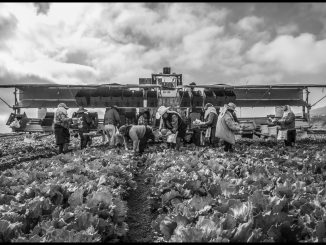
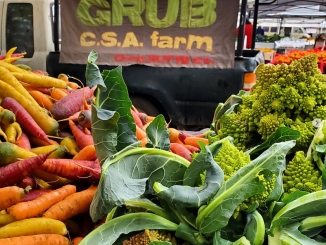
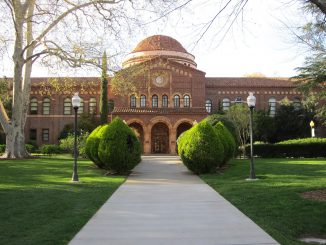
Be the first to comment